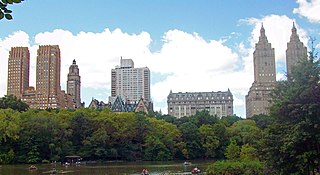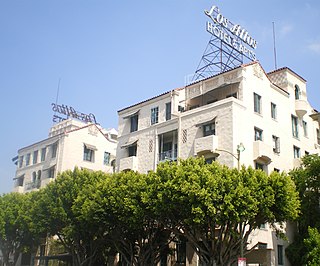
A landlord is the owner of a house, apartment, condominium, land, or real estate which is rented or leased to an individual or business, who is called a tenant. When a juristic person is in this position, the term landlord is used. Other terms include lessor and owner. The term landlady may be used for the female owners. The manager of a pub in the United Kingdom, strictly speaking a licensed victualler, is referred to as the landlord/landlady. In political economy it refers to the owner of natural resources alone from which an economic rent is the income received.

Eviction is the removal of a tenant from rental property by the landlord. In some jurisdictions it may also involve the removal of persons from premises that were foreclosed by a mortgagee.

A housing cooperative, or housing co-op, is a legal entity, usually a cooperative or a corporation, which owns real estate, consisting of one or more residential buildings; it is one type of housing tenure. Housing cooperatives are a distinctive form of home ownership that have many characteristics that differ from other residential arrangements such as single family home ownership, condominiums and renting.

Aimco or Apartment Investment and Management Company is a publicly traded real estate investment trust. As of December 31, 2020, the company owned 27 apartment communities comprising 6,342 apartment units in 12 states and the District of Columbia.

Single room occupancy is a form of housing that is typically aimed at residents with low or minimal incomes who rent small, furnished single rooms with a bed, chair, and sometimes a small desk. SRO units are rented out as permanent residence and/or primary residence to individuals, within a multi-tenant building where tenants share a kitchen, toilets or bathrooms. SRO units range from 7 to 13 square metres. In some instances, contemporary units may have a small refrigerator, microwave, or sink.
Landlord harassment is the willing creation, by a landlord or their agents, of conditions that are uncomfortable for one or more tenants in order to induce willing abandonment of a rental contract. This is illegal in many jurisdictions, either under general harassment laws or specific protections, as well as under the terms of the rental contracts or tenancy agreements.

Penn South, officially known as Mutual Redevelopment Houses and formerly Penn Station South, is a limited-equity housing cooperative development located between Eighth and Ninth Avenues and West 23rd and 29th Streets, in the Chelsea neighborhood of Manhattan, New York City. The complex has 2,820 units in ten 22-story buildings. Penn South is so named because of its location southwest of New York Penn Station.
CitiApartments was one of the largest real estate companies in San Francisco, California, which at its peak owned and managed more than 300 buildings directly and through a number of affiliates. In recent years the companies suffered a financial downturn, and have been the subject of intense criticism and litigation for allegedly illegal business practices as a residential landlord.
Equity Residential is a publicly traded real estate investment trust that invests in apartments.
Rent control in New York is a means of limiting the amount of rent charged on dwellings. Rent control and rent stabilization are two programs used in parts of New York state. In addition to controlling rent, the system also prescribes rights and obligations for tenants and landlords.
Overdale was a small residential district in downtown Montreal that became a famous symbol of the struggle between urban conservationists and land developers.

El Greco Apartments is a historic twelve-unit, Spanish Revival style apartment building located in the Fairfax district of Los Angeles, California. The building was built in 1929 as one of the original buildings in the Westwood Village section of Los Angeles. Located in the heart of Westwood, the building was the home of film celebrities, including Erich von Stroheim, Michael Curtiz, and Joel McCrea. In the 1980s, the owner planned to demolish the building to erect a new condominium building. Met by tenant protests, the owner agreed to pay to have the building moved to another location. The building was ultimately moved to the Fairfax district where it was converted to low-income housing for senior citizens.

Chateau Colline is an historic eight-unit apartment building on Wilshire Boulevard in the Westwood section of Los Angeles, California.

The Los Altos Apartments is a Mission Revival-style apartment building on Wilshire Boulevard in Los Angeles, California.
The Coalition for Economic Survival, or CES is a grassroots, non-profit community organization. CES works in the greater Los Angeles area in working to influence policy makers to improve the lives of low and moderate income people.
René G. Lépine, Sr. was a Canadian real estate developer and philanthropist. Lépine was the chairman of Groupe Lépine, a real estate development and investment firm he founded in 1953. He is widely considered one of the most influential French Canadian real estate developers of his time. His companies developed over $5 billion of real estate in Canada and the United States since the 1960s. He also owned a portfolio of multifamily and retail properties in Montreal and Ottawa. Lépine developed many buildings considered landmarks in Montreal, including the Olympic Village and Le Sanctuaire du Mont-Royal. Lépine is also credited with having developed the first condominiums in Montreal in 1981.
The Ellis Act is a 1985 California state law that allows landlords to evict residential tenants to "go out of the rental business" in spite of desires by local governments to compel them to continue providing rental housing.

Historic Oaks of Allen Parkway Village, formerly Allen Parkway Village (APV) and San Felipe Courts Apartments, is a public housing complex in the northern Fourth Ward, Houston, Texas, operated by the Houston Housing Authority (HHA). Allen Parkway Village occupies 37 acres (15 ha) of land.
The Murray Apartments and Cottages are a small cluster of historic residential properties at 200, 204, and 206 Seward Street, on the edge of the business district of Sitka, Alaska. Two of the buildings are 1+1⁄2-story frame cottages, while the third, also known as the Murray Flats and the Baranof Apartments, is a 2+1⁄2-story frame structure housing four apartments. These buildings originally stood in Douglas, Alaska, and were disassembled and moved to Sitka in 1921 by Abner Murray. They represent the first buildings erected in Sitka specifically intended as residential housing rental units; the apartment house was the first multi-unit residential unit in Sitka to be built since the Alaska Purchase in 1867.
The Costa–Hawkins Rental Housing Act ("Costa–Hawkins") is a California state law, enacted in 1995, which places limits on municipal rent control ordinances. Costa–Hawkins preempts the field in two major ways. First, it prohibits cities from establishing rent control over certain kinds of residential units, e.g., single-family dwellings and condominiums, and newly constructed apartment units; these are deemed exempt. Second, it prohibits "vacancy control", also called "strict" rent control. The legislation was sponsored by Democratic Senator Jim Costa and Republican Assemblymember Phil Hawkins.















